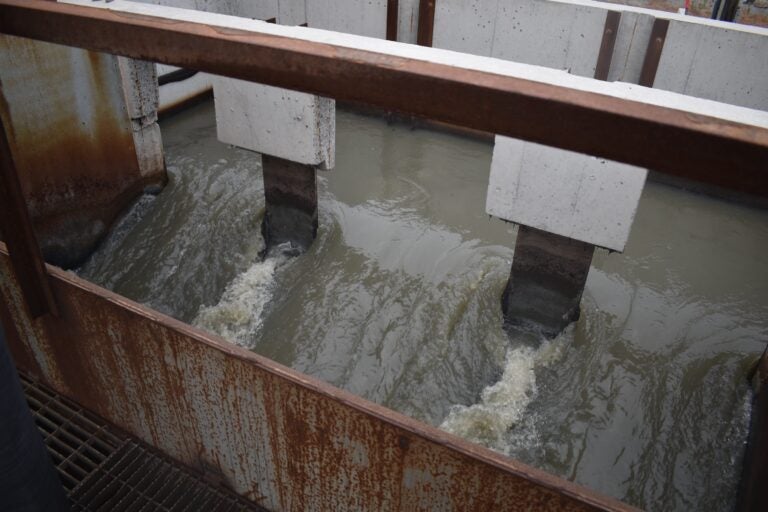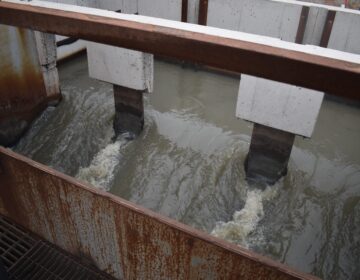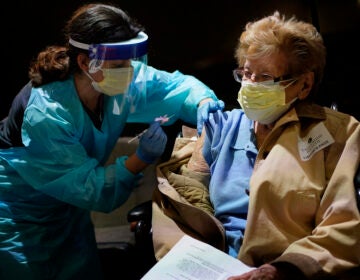With less public testing, Delaware sewers provide a clearer view of COVID numbers
Massive public testing sites created at the onset of the pandemic have been largely dismantled. But analysis of wastewater for COVID-19 is still going strong.

Samples of wastewater from sewers in New Castle County reveal a clear picture of coronavirus cases. (Courtesy of New Castle County)
The COVID-19 pandemic has changed everything. What should we know about how you approach the world now? How has the pandemic changed your social life, your work life, your interactions with your neighbors? Get in touch here.
While the pandemic’s worst effects ease, death rates decline, and vaccination rates rise, Delaware’s communities are still affected. While the state’s case numbers remain far below January’s peak, the massive public testing sites created to track those cases have been largely dismantled.
As cases crested in January, the state was testing more than 10,000 people per day. As of mid-July, that number is less than 2,000.
That decrease in clinical testing hasn’t stopped New Castle County from getting a clear picture of the virus in Delaware’s most populous county. Since the early days of the pandemic, the county has turned to its sewers to identify patterns and predict COVID-positive cases.
Scientists from all over the world began examining wastewater at the beginning of 2020 after discovering evidence that coronavirus infection can be found in human feces.
“It provides another means of trying to understand the pandemic and was very useful, especially in the beginning of the pandemic when testing data wasn’t quite there yet,” said Michael Harris, Stormwater and Environmental Programs manager for the county.
At the start of the pandemic, New Castle County collaborated with Biobots Analytics, a company in Boston, Massachusetts, to analyze wastewater for the COVID-19 virus because the disease can be identified by the shed that the body releases. Later that year, in August 2020, the county teamed up with the University of Delaware’s Center for Environmental and Wastewater Epidemiological Research, also known as CEWER.
“We’re basically just filtering and concentrating wastewater and then extracting the nucleic acid, the RNA from the virus and looking to detect the virus,” said CEWER co-director Kali Kniel, who also works as a professor of Animal and Food Sciences at UD. Kniel said the sewer monitoring system uses a digital Polymerase Chain Reaction that provides measures for the virus genetic material similar to the antigen at-home test kits.
Using sewers to look for COVID is effective in spotting population patterns and spot environmental and societal issues, but it’s not intended to take the place of clinical testing.
In June, the county signed a new contract in an effort to get a deeper understanding of the various feces variations.
Since then, scientists and researchers have spotted trends among the various COVID variants, including the alpha, delta, and omicron versions of the virus.
“For example, the spike with the delta variant, and when we saw this spike with the omicron variant, both of those, you see those spikes as well in wastewater where you see more infected individuals,” Kniel said.
According to Harris, these samples and tests reveal which variations in New Castle County are generating surges in illness. He thinks these studies will be useful right now, especially given how few people are undergoing tests.
Wastewater testing is now happening statewide and the state Dept. of Health and Social Services is “working with the CDC to develop, certify, and expand the testing techniques to ultimately detect additional organisms,” said the Div. of Public Health’s Sergio Huerta.
It has become more challenging to monitor positive cases as a result of the decline in clinical testing, particularly because it is impossible for the state to determine who has used an at-home antigen test kit. In order to detect the serious spread of disease, public health officials have been closely watching COVID admission numbers at the state’s hospitals.
As of July 20, there were 151 patients hospitalized for the virus. Three months ago, there were less than 50 in state hospitals.
The lower case numbers led the University of Delaware to discontinue its testing requirements for students, at least for the summer. The school has not announced its testing plans for students returning to the Newark campus this fall.
As for sewer testing, the methodology is reliable, Kniel said, and it has lots of applications beyond COVID.
Similar methods can be used to keep track of rising viruses like cholera, hepatitis A, and poliovirus as well as antibiotic resistance.
“We can use the same methodology to look for other viruses as well. Influenza virus, norovirus, the virus that makes people, you know, have sort of a vomiting diarrhea for 24 hours,” Kniel said. “We can also look for antibacterial resistance or antimicrobial resistance genes.”
Others have used this technology to test for opioids in sewer systems so they may determine where people are using illicit substances or producing pharmaceuticals. This work was carried out in Cary, North Carolina, where authorities were able to reduce overdoses through interventions and public education programs.
WHYY is your source for fact-based, in-depth journalism and information. As a nonprofit organization, we rely on financial support from readers like you. Please give today.





![CoronavirusPandemic_1024x512[1]](https://whyy.org/wp-content/uploads/2020/03/CoronavirusPandemic_1024x5121-300x150.jpg)


